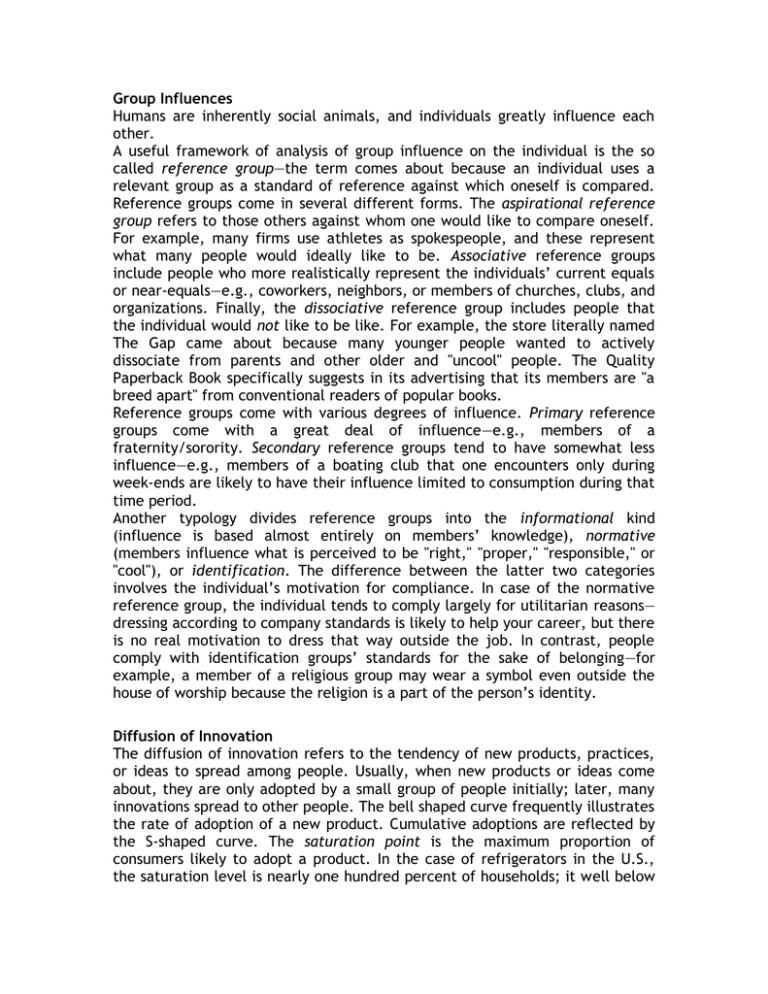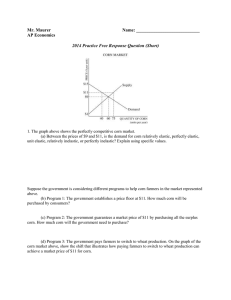Group Influences other.
advertisement

Group Influences Humans are inherently social animals, and individuals greatly influence each other. A useful framework of analysis of group influence on the individual is the so called reference group—the term comes about because an individual uses a relevant group as a standard of reference against which oneself is compared. Reference groups come in several different forms. The aspirational reference group refers to those others against whom one would like to compare oneself. For example, many firms use athletes as spokespeople, and these represent what many people would ideally like to be. Associative reference groups include people who more realistically represent the individuals’ current equals or near-equals—e.g., coworkers, neighbors, or members of churches, clubs, and organizations. Finally, the dissociative reference group includes people that the individual would not like to be like. For example, the store literally named The Gap came about because many younger people wanted to actively dissociate from parents and other older and "uncool" people. The Quality Paperback Book specifically suggests in its advertising that its members are "a breed apart" from conventional readers of popular books. Reference groups come with various degrees of influence. Primary reference groups come with a great deal of influence—e.g., members of a fraternity/sorority. Secondary reference groups tend to have somewhat less influence—e.g., members of a boating club that one encounters only during week-ends are likely to have their influence limited to consumption during that time period. Another typology divides reference groups into the informational kind (influence is based almost entirely on members’ knowledge), normative (members influence what is perceived to be "right," "proper," "responsible," or "cool"), or identification. The difference between the latter two categories involves the individual’s motivation for compliance. In case of the normative reference group, the individual tends to comply largely for utilitarian reasons— dressing according to company standards is likely to help your career, but there is no real motivation to dress that way outside the job. In contrast, people comply with identification groups’ standards for the sake of belonging—for example, a member of a religious group may wear a symbol even outside the house of worship because the religion is a part of the person’s identity. Diffusion of Innovation The diffusion of innovation refers to the tendency of new products, practices, or ideas to spread among people. Usually, when new products or ideas come about, they are only adopted by a small group of people initially; later, many innovations spread to other people. The bell shaped curve frequently illustrates the rate of adoption of a new product. Cumulative adoptions are reflected by the S-shaped curve. The saturation point is the maximum proportion of consumers likely to adopt a product. In the case of refrigerators in the U.S., the saturation level is nearly one hundred percent of households; it well below that for video games that, even when spread out to a large part of the population, will be of interest to far from everyone. Several specific product categories have case histories that illustrate important issues in adoption. Until some time in the 1800s, few physicians bothered to scrub prior to surgery, even though new scientific theories predicted that small microbes not visible to the naked eye could cause infection. Younger and more progressive physicians began scrubbing early on, but they lacked the stature to make their older colleagues follow. ATM cards spread relatively quickly. Since the cards were used in public, others who did not yet hold the cards could see how convenient they were. Although some people were concerned about security, the convenience factors seemed to be a decisive factor in the "tug-of-war" for and against adoption. The case of credit cards was a bit more complicated and involved a "chickenand-egg" paradox. Accepting credit cards was not a particularly attractive option for retailers until they were carried by a large enough number of consumers. Consumers, in contrast, were not particularly interested in cards that were not accepted by a large number of retailers. Thus, it was necessary to "jump start" the process, signing up large corporate accounts, under favorable terms, early in the cycle, after which the cards became worthwhile for retailers to accept. Rap music initially spread quickly among urban youths in large part because of the low costs of recording. Later, rap music became popular among a very different segment, suburban youths, because of its apparently authentic depiction of an exotic urban lifestyle. Hybrid corn was adopted only slowly among many farmers. Although hybrid corn provided yields of about 20% more than traditional corn, many farmers had difficulty believing that this smaller seed could provide a superior harvest. They were usually reluctant to try it because a failed harvest could have serious economic consequences, including a possible loss of the farm. Agricultural extension agents then sought out the most progressive farmers to try hybrid corn, also aiming for farmers who were most respected and most likely to be imitated by others. Few farmers switched to hybrid corn outright from year to year. Instead, many started out with a fraction of their land, and gradually switched to 100% hybrid corn when this innovation had proven itself useful. Several forces often work against innovation. One is risk, which can be either social or financial. For example, early buyers of the CD player risked that few CDs would be recorded before the CD player went the way of the 8 track player. Another risk is being perceived by others as being weird for trying a "fringe" product or idea. For example, Barbara Mandrell sings the song "I Was Country When Country Wasn’t Cool." Other sources of resistance include the initial effort needed to learn to use new products (e.g., it takes time to learn to meditate or to learn how to use a computer) and concerns about compatibility with the existing culture or technology. For example, birth control is incompatible with strong religious influences in countries heavily influenced by Islam or Catholicism, and a computer database is incompatible with a large, established card file. Innovations come in different degrees. A continuous innovation includes slight improvements over time. Very little usually changes from year to year in automobiles, and even automobiles of the 1990s are driven much the same way that automobiles of the 1950 were driven. A dynamically continuous innovation involves some change in technology, although the product is used much the same way that its predecessors were used—e.g., jet vs. propeller aircraft. A discontinous innovation involves a product that fundamentally changes the way that things are done—e.g., the fax and photocopiers. In general, discontinuous innovations are more difficult to market since greater changes are required in the way things are done, but the rewards are also often significant. Several factors influence the speed with which an innovation spreads. One issue is relative advantage (i.e., the ratio of risk or cost to benefits). Some products, such as cellular phones, fax machines, and ATM cards, have a strong relative advantage. Other products, such as automobile satellite navigation systems, entail some advantages, but the cost ratio is high. Lower priced products often spread more quickly, and the extent to which the product is trialable (farmers did not have to plant all their land with hybrid corn at once, while one usually has to buy a cellular phone to try it out) influence the speed of diffusion. Finally, the extent of switching difficulties influences speed—many offices were slow to adopt computers because users had to learn how to use them. Some cultures tend to adopt new products more quickly than others, based on several factors: o Modernity : The extent to which the culture is receptive to new things. In some countries, such as Britain and Saudi Arabia, tradition is greatly valued—thus, new products often don’t fare too well. The United States, in contrast, tends to value progress. o Homophily: The more similar to each other that members of a culture are, the more likely an innovation is to spread—people are more likely to imitate similar than different models. The two most rapidly adopting countries in the World are the U.S. and Japan. While the U.S. interestingly scores very low, Japan scores high. o Physical distance: The greater the distance between people, the less likely innovation is to spread. o Opinion leadership: The more opinion leaders are valued and respected, the more likely an innovation is to spread. The style of opinion leaders moderates this influence, however. In less innovative countries, opinion leaders tend to be more conservative, i.e., to reflect the local norms of resistance. It should be noted that innovation is not always an unqualifiedly good thing. Some innovations, such as infant formula adopted in developing countries, may do more harm than good. Individuals may also become dependent on the innovations. For example, travel agents who get used to booking online may be unable to process manual reservations. Sometimes innovations are disadopted. For example, many individuals disadopt cellular phones if they find out that they don’t end up using them much.





